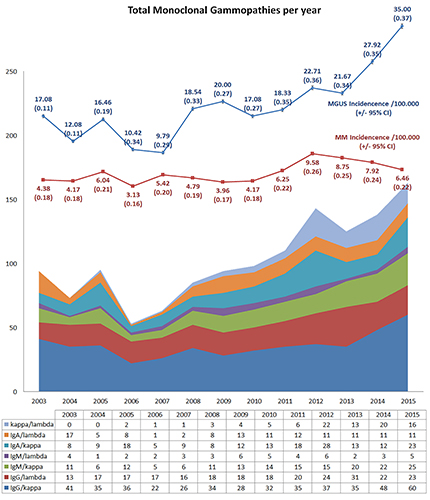
Contributions
Abstract: PB1984
Type: Publication Only
Background
Monoclonal gammopathy (MG) is the most common plasma cells disorder. It affects around 3% of the population older than 50 years. The great majority of MG are monoclonal gammopathies of undetermined significance (MGUS), which is a premalignant disorder defined to present less than 3 g/dL of serum monoclonal protein, less than 10% of clonal bone marrow cells and absence of end-organ damage. MGUS is easily detected in laboratory tests and should be monitored because 1% of MGUS per year progress to Multiple Myeloma (MM).
Aims
The aim of this study is to determine the incidence of MGUS, MM and its different types in the reference population of a tertiary hospital in southern Spain between 2003 and 2015.
Methods
In a retrospective study, we determined the total number of MG and its different types diagnosed in our hospital between 2003 and 2015. We calculated the incidence per 100.000/year of MGUS and MM, with 95% confidence intervals. Our reference population, in 2015, was 480.851.
Results
Results in the figure attached.

Conclusion
The aging of population and the higher sensitivity of laboratory techniques for diagnosing of MG is reflected in the incidence of MGUS, which increased from 17.04 cases per 100.000 in 2003 to 35.00. MM incidence in our area did not increased in parallel.
Session topic: 14. Myeloma and other monoclonal gammopathies - Clinical
Keyword(s): Incidence, Free light chain, Multiple Myeloma, Monoclonal gammopathy
Abstract: PB1984
Type: Publication Only
Background
Monoclonal gammopathy (MG) is the most common plasma cells disorder. It affects around 3% of the population older than 50 years. The great majority of MG are monoclonal gammopathies of undetermined significance (MGUS), which is a premalignant disorder defined to present less than 3 g/dL of serum monoclonal protein, less than 10% of clonal bone marrow cells and absence of end-organ damage. MGUS is easily detected in laboratory tests and should be monitored because 1% of MGUS per year progress to Multiple Myeloma (MM).
Aims
The aim of this study is to determine the incidence of MGUS, MM and its different types in the reference population of a tertiary hospital in southern Spain between 2003 and 2015.
Methods
In a retrospective study, we determined the total number of MG and its different types diagnosed in our hospital between 2003 and 2015. We calculated the incidence per 100.000/year of MGUS and MM, with 95% confidence intervals. Our reference population, in 2015, was 480.851.
Results
Results in the figure attached.

Conclusion
The aging of population and the higher sensitivity of laboratory techniques for diagnosing of MG is reflected in the incidence of MGUS, which increased from 17.04 cases per 100.000 in 2003 to 35.00. MM incidence in our area did not increased in parallel.
Session topic: 14. Myeloma and other monoclonal gammopathies - Clinical
Keyword(s): Incidence, Free light chain, Multiple Myeloma, Monoclonal gammopathy


